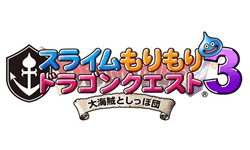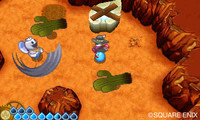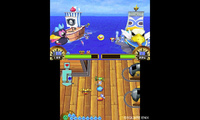|
|

|
PLATFORM
|
DS
|
BATTLE SYSTEM
|

|
INTERACTION
|

|
ORIGINALITY
|

|
STORY
|

|
MUSIC & SOUND
|

|
VISUALS
|

|
CHALLENGE
|
Unbalanced
|
LANGUAGE BARRIER
|
Moderate
|
COMPLETION TIME
|
20-40 Hours
|
|
OVERALL

|
+ Includes all the fun from previous games
+ Cutesy sprite graphics
- Starts way too easy; post-game way too hard
- Slimes not as individualized anymore
- Extreme synthing bottlenecks
|
Click here for scoring definitions
|
|
|
There have been plenty of oddball Dragon Quest spinoffs over the years, but few are as cute as the Slime Mori-Mori games. These action-adventure titles put the whole of the action into the non-existent hands of DQ's signature monster, the little blue slime. Slime Mori-Mori Dragon Quest III: Dai Kaizoku to Shippo-dan (Pirates and Plob) follows in the slime trail of its popular predecessor, Rocket Slime, with some new tricks and features, but beneath it all is the same pudgy blue thing we've all come to know and love.
Mori-Mori III is notable for having a plot that's largely different from its two predecessors (which started out in almost identical fashion). This time around, the hero — let's call him Cannon — is the prince of the slime kingdom. He spends most of his days messing around with his friends on the royal warship. One day, the Platypus Mob (or Plob) crashes in, hoping to steal the seven Rainbow Orbs from the kingdom's tallest tower. All this does is scatter the orbs around the world, so now the chase is on for Cannon and his friends to retrieve the maguffins before the Plob can. There isn't much more to the story, with the very few plot points all involving either gimmicks in the levels or the sea charts needed to proceed further. It's really only there to justify the gameplay — and for a series this cute and fun, not much justification is needed.
The change of basic plot is the cause of many differences between this game and the first two of its series. First, there have been no slime-nappings, and there are no captive citizens waiting around to be rescued. This has had a major effect on the dungeon layouts, which feel more straightforward than in Rocket Slime. It also means that most of the slimes in the game no longer have silly, punny names attached, but rather are referred to simply as 'villager,' 'old man,' etc. While this isn't a big deal, a lot of the charm of Mori-Mori and Rocket Slime had to do with the citizens of Boingberg and the little thank-you notes they would send when they were rescued, so their lack feels like a net loss.
One of the things gained is a world map. Mori-Mori III takes a page, or rather a chart, from Dragon Quest III, borrowing the general outline of the real world continents while reducing the details to humorous stereotypes. It's unfortunate that this never got the chance for a silly localization, but it is easy to imagine. There'd be the continent of deserts and baobabs, Slurfrica, with its grand Sphinx and mysterious Pointy Tombs. North of it would lie the land of Flanse on the continent of Slurropa, whose grand château houses a chef-d'œvre by the famous Dabbler Duckasso. Then there would be Slushia, land of Arctic chill and matryoshka dolls, and the far-off continent of Austraslimia with skull-tossing kangaroos and dinosaur bones galore. North Slimerica would be represented by cowboys, slickshooters, and the Idol of Freedom, while South Slimerica gets rain forests and giant pictures in the ground. Finally, there'd be the Plob stronghold of Platypan, under the shadow of Mt. Platypuji. Yes, it's easy to imagine what might have been done with material like this.
 That's some slick shooting.
That's some slick shooting.
|
|
Ship battles take place solely on the world map and follow the same general pattern as tank battles in Rocket Slime. Just about everything and the kitchen sink gets blasted out of cannons in these fights, as the player seeks to wear the other ship down so that it can be boarded. Victory happens when Cannon successfully reaches the enemy's engine room and blows it up. It's up to the player to fill the ship's deck with all manner of odds and ends, most of variable but interesting use. Ducktor Cid is also back, with his shipwright services available fairly early in the game. The only real annoyance lies in how long it takes for Cannon to get any real help from his friends. The game won't let the player set a crew until almost halfway through.
The new and cool addition to the big ship battles is the ability to summon previously defeated bosses. These major monsters always drop an item when Cannon takes them down, and the summoning begins when this item is shot at the enemy ship. As it flies through the air, the boss will appear in the background, charging up for the big attack. If the item makes a successful hit, then it's time for some massive damage. Only one summoning can be active at a time, and non-active summoning items do paltry damage, so this makes for an interesting strategic addition to gameplay.
Item synthesis is available from the very beginning, but things get well out of hand by the end. Most of the high-end items will be made to satisfy Ducktor Cid's matériel needs while improving the HMS Boingberg, and there are some serious bottlenecks in the process. The only things gained from ship battles are money and ship schemata (used to mix and match designs), so the player is reliant on what can be made or found — and none of the really good items can be picked up just like that. The item synth system will have to work overtime to get everything necessary. Considering how much orichalcum it takes to finish the upgrades (upwards of fifty pieces, with only one consistent source in an annoying volcano level), and that's only one of several bottlenecks, it's an awful chore to both fully trick out the ship and provide it with the top-grade armory it needs to take on some of the post-game content.
 Prepare to repel slimers!
Prepare to repel slimers!
|
|
The graphics are an interesting juxtaposition of elements. The world map, the ships, the bosses, and some of the level scenery are all rendered in 3D modeling, but everything else is done in the same cutesy sprite graphics as Rocket Slime and the original Mori-Mori game on the GBA. Given how well the graphics of those games fit the tone and needs of the gameplay, this could be seen as a case of not fixing what wasn't broken. Likewise, all the sound effects and music have been inherited from previous games, because it already fit so well together.
This is not a difficult game, but that's not exactly the best thing. If anything, it can be too easy, especially at the beginning when Cannon starts with far more health points than he could possibly lose in combat. Then the final boss comes along with a difficulty level more appropriate to the end of the game, which makes him ten times more difficult than anything else seen in the game. The less said about post-game difficulty, the better. The main game can possibly be finished in under twenty hours, but it's far more likely the player will need to take time to build up supplies and improve the HMS Boingberg before successfully defeating the final ship battle.
More than a half-dozen enemies have been added to the roster, as well as a variety of items, with tricks and traits that are interesting if not always necessary. For example, it's cool that Flame monsters actually extinguish when thrown in water, but there's only one spot in one level in the entire game where the necessary conditions are even possible. It's things like that which suggest that a lot more could have been done with this game.
And really, that's the only complaint that matters here. Slime Mori-Mori Dragon Quest III is cute and fun, but it could have been even more entertaining, with larger levels, more monsters, and more gimmicks. But that's the way the slime bounces, I suppose. It's still a good little game, just not an exceptional one.
Review Archives
|









